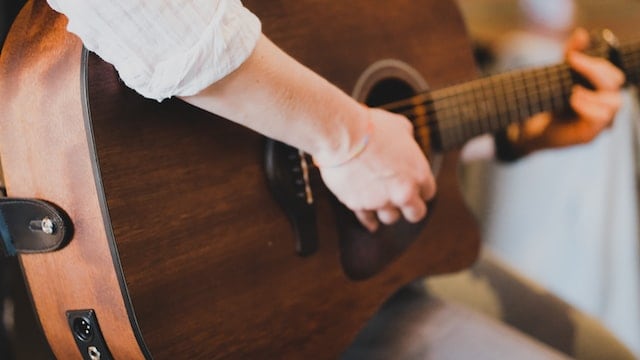Fingers.
Such noble tools from evolution. What would we do without them?
They have granted us the possibility of creating weapons, building shelters, and of course, picking our noses. Thank you mother nature!
Oh, sure, and they are one of the main reasons why music is possible.
Guitarists need fingers to play guitar, there’s no doubt about it.
So, it’s obvious to think about taking care of them. Naturally, if there are no healthy fingers, then there is no music at all.
Unfortunately, guitar finger pain is a thing. And if your fingers are in pain, then playing becomes more difficult.
How can you avoid this problem, to begin with?
Some of the most effective ways to prevent guitar finger pain are playing with light gauge strings, and with a lower guitar action. Also, get used to pressing down strings without exerting too much effort. Lastly, get into the habit of developing callouses, and playing for shorter periods.
We mentioned just a few for you to get a general idea. However, we covered 8 forms in which you can avoid finger pain.
Find them below, and see which one will bring you the most accurate results.
What is the cause of finger pain when playing guitar?
Although playing guitar seems like a harmless exercise, you might end up hurting yourself a bit.
Of course, we’re referring to finger pain.
While guitar finger pain is not a drastic injury, it’s undoubtedly a nuisance.
But why do our fingers hurt after playing, anyway? It’s not as if guitar strings were extra hard.
The truth is that our fingers are not used to receiving constant pressure on their tips. Unless, of course, we use them to play bass or guitar.
So, it’s obvious that our fingers will hurt and/or develop callouses if they are not used to pressing hard on metal strings.
Apply the same logic to another muscle in your body.
The first time you go to the gym, you’ll be exerting effort on new areas of your body. By “new” we mean parts and muscles that we rarely use to accomplish daily activities.
All of a sudden, these unused muscles are receiving lots of stress. As a result, they will ache the next day.
Naturally, the more you exercise, the more resistance you build.
The same happens with the fingers. The more you play, the less your fingers will hurt.
What’s more, this constant contact creates blunt trauma and wears your fingertips’ skin away, uncovering the more sensitive parts of your flesh.
Last but not least, we need to mention the inflammatory conditions that could be presented.
These may appear not only on your fingers but in your wrist.
Luckily, this will occur only if you force your fingers too much. The inflammation appears as a result of not resting your tired fingers.
You should be attentive to your finger pain in order to avoid long-term problems.
Is finger pain normal when playing guitar?
Beginners might feel uneasy if they notice their fingers hurt badly after practicing for some time.
Fortunately, finger pain is common when starting to play guitar. To be honest, it’s even expected.
If your fingers hurt, then that’s a clear sign that you have been practicing.
Bear in mind, though, that this pain should be temporary, and not constant.
If they hurt a day or two, then that’s okay. But what if your fingers are in constant pain?
If that’s the case, then you must take urgent action. Otherwise, some of the issues mentioned before (inflammation, cutting your fingertip skin open, etc.) could appear.
So, here we present 8 forms in which you can avoid your fingers from hurting.
8 effective ways for preventing finger pain when playing guitar
Here’s the full list with the tips.
Some of them are meant to be applied before practicing. Others are to be implemented while playing guitar.
Lastly, you’ll find a few to do after playing, and once you leave your guitar back in its case.
1. Develop callouses
Callouses are a kind of cushion that shelters your fingertips from the hard, cold strings.
They avoid finger pain since strings won’t touch the soft skin of your fingertips.
Callouses take between 2 and 4 weeks approximately to form completely.
During those two, three, or four weeks, it’s recommended to practice regularly, but for shorter periods of time (give your fingertips some time to rest).
Additionally, you can play with strings of a thicker gauge. After all, the thinner the gauge, the more likely they’ll cut your tips open.
Lastly, we encourage you to apply alcohol to your tips after playing. Alcohol will dry your fingertips, facilitating the callouses formation process.
2. Press strings softly
Overall, the guitar is, arguably, a rather simple instrument to play.
However, getting used to pressing the strings against the fretboard could take some time.
What’s natural is to press strings as hard as possible, in order to achieve the expected sound when creating a chord.
After all, if strings are not pressed hard enough, some notes could sound muted.
Nonetheless, we encourage you to accustom your fingers to press the strings down softly.
This should be taken into consideration with the first and second strings specially. Consider that these are the thinnest strings on a guitar.
If you exert too much pressure on the first and second strings, then you run the risk of cutting your fingertips (or at least causing sharp pain).
Take it easy, and press strings gently until you develop some callouses.
3. Regular rehearsals; fewer minutes
We highly encourage you to practice as much as you can.
If you want to rehearse six hours a day, then do it! Now, if your fingers keep hurting, then you might decide to take some rest occasionally.
It’s recommended to play regularly, but, instead of spending 2 or 3 hours non-stop, you may try practicing for 20 minutes or half an hour.
Then, take some rest. Repeat the process as many times as you want.
4. Lower the guitar’s action
High-action guitars are harder to play.
This is because the distance between the strings and the fretboard is too much. As a consequence, one needs to push harder to play notes or chords.
On the contrary, by lowering the action (thus, reducing the distance), the distance shortens, and one can play chords more easily.
This simple modification will avoid producing finger pain.
5. Apply cold water after playing
Press a cold compress on your fingers for a while as soon as you finish playing.
You may also try sinking the fingertips in cold water for some minutes.
6. Wear fingertip protectors
If you have cut your skin deeply, but you just cannot stop playing, then maybe these protectors could work (either that, or let your fingers bleed out as Zakk Wylde did).
Guitar fingertip protectors are, as the name implies, plastic protectors that cover your finger’s skin.
While these might be useful if your fingers are in sharp pain, we highly encourage you not to play with them.
It’s better no develop natural callouses.
7. Avoid playing with wet fingers
Wet fingers are softer, which means they are less resistant than dry fingers, which means that they run the risk of getting hurt more easily.
So, don’t play guitar as soon as you finish taking a shower, watering the plants, swimming in the ocean, or sucking your own fingers (hey, we all have anxious behavior, don’t worry).
8. Change your guitar strings often
Having old, rusty strings will most likely damage your fingers sooner or later.
On the contrary, brand-new strings are way more comfortable and less likely to produce finger pain.
9. Use lighter gauge strings
Lighter gauge strings are easier on the fingers and don’t offer any real drawbacks unless you use certain alternate tunings.
Always stick to strings that feel most comfortable to you.
Remember to stop playing if your fingers hurt
It’s okay to feel some discomfort after playing too much.
Callouses are natural and even expected when practicing guitar.
The problem is when your soft skin gets badly hurt. If you keep on playing that way, you don’t give time to your fingertips to develop callosity.
But even if you do bleed your fingers, this is the least of your problems.
With alcohol and some bandages, finger cuts will be cured.
The real problem is when your entire fingers hurt from playing guitar.
Worst case scenario, you end up developing a disease that affects you long-term.
We highly encourage you to give up on playing for some hours if you feel your fingers hurt a lot.
Also, don’t forget to apply some of the 8 tips we mentioned in this article.
They are effective tools that will help you play and take care of yourself.

Hello there, my name is Ramiro and I’ve been playing guitar for almost 20 years. I’m obsessed with everything gear-related and I thought it might be worth sharing it. From guitars, pedals, amps, and synths to studio gear and production tips, I hope you find what I post here useful, and I’ll try my best to keep it entertaining also.





